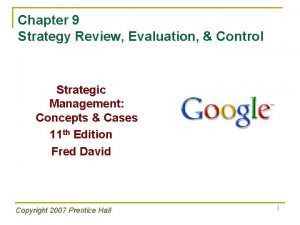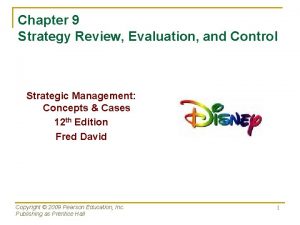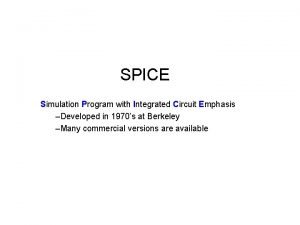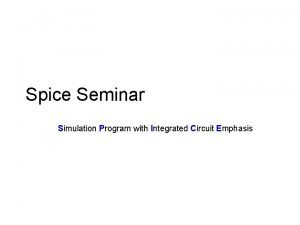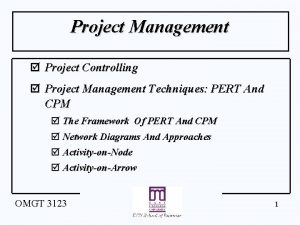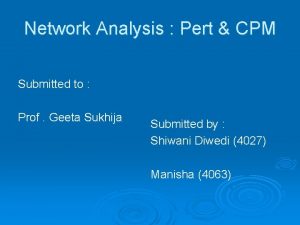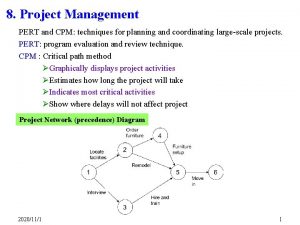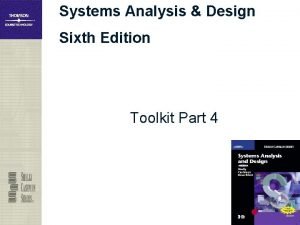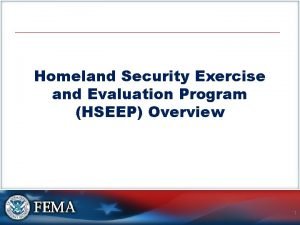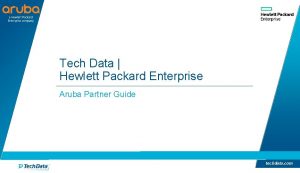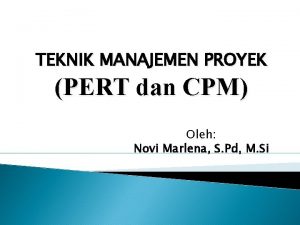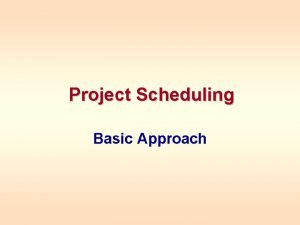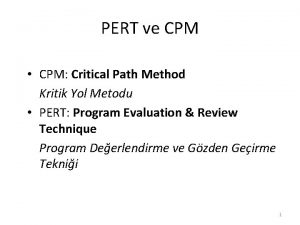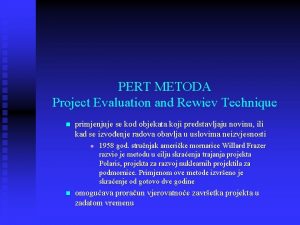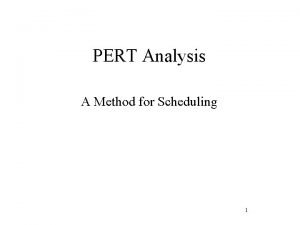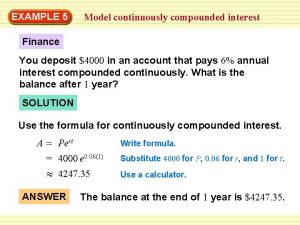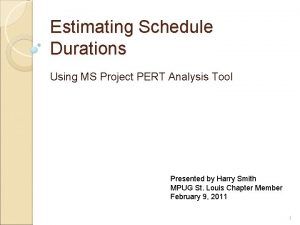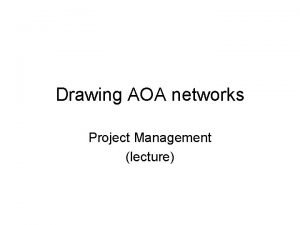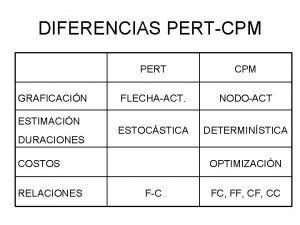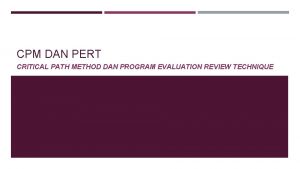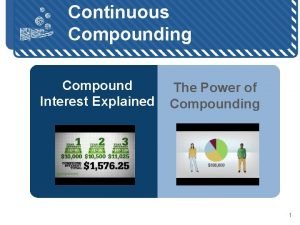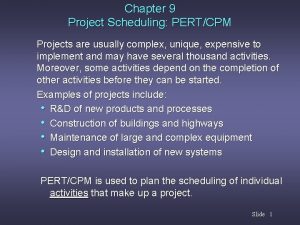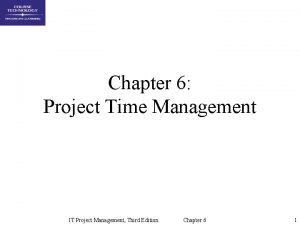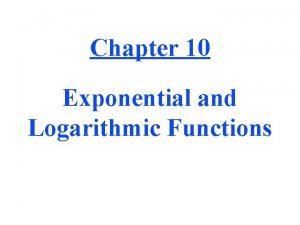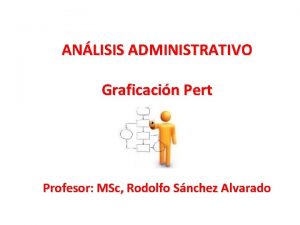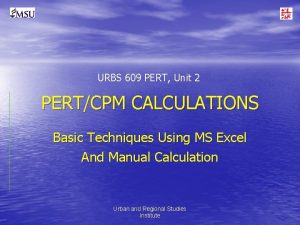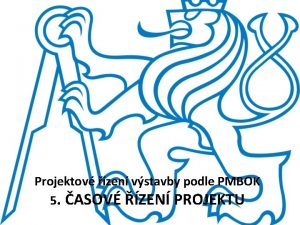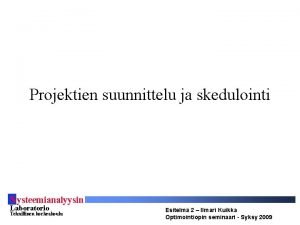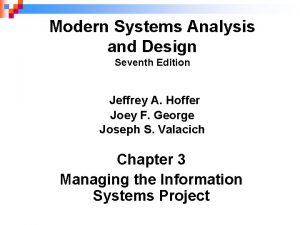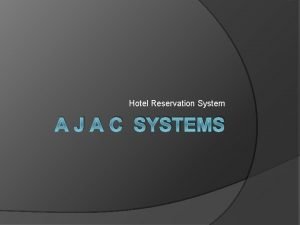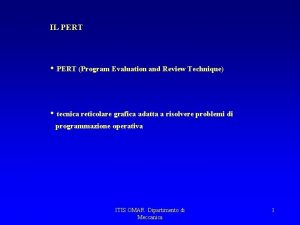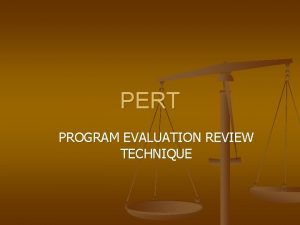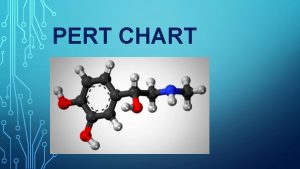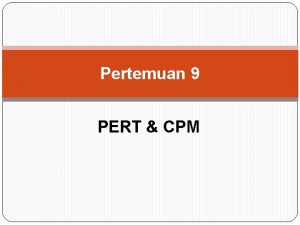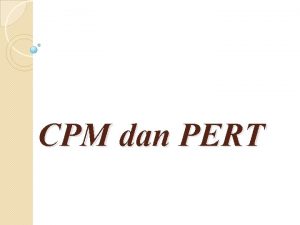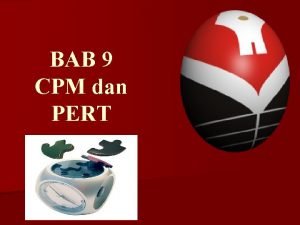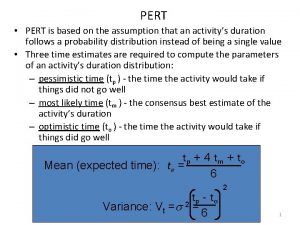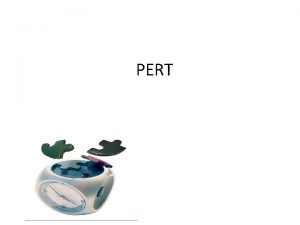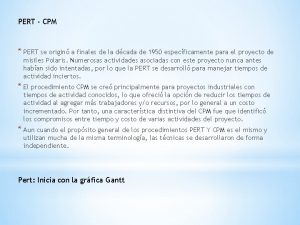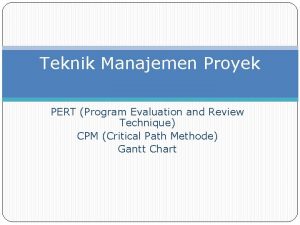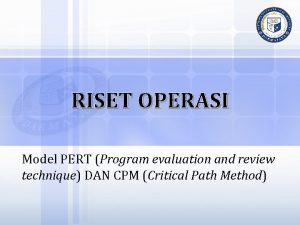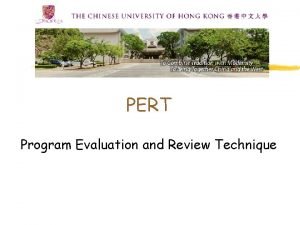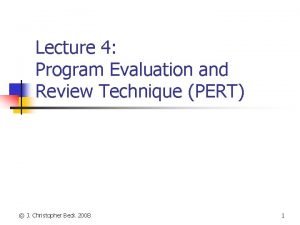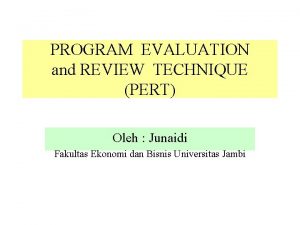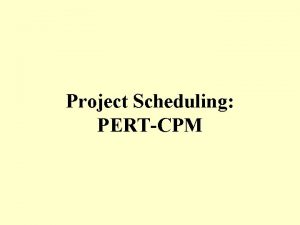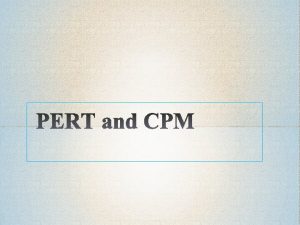Simulation of PERT Networks Program evaluation and review



















































- Slides: 51

Simulation of PERT Networks • Program evaluation and review technique (PERT) • is a statistical tool used in project management, which was designed to analyze and represent the tasks involved in completing a given project. • First developed by the United States Navy in the 1950 s. • It is commonly used in conjunction with the critical path method (CPM). • PERT is a method of analyzing the tasks involved in completing a given project, especially the time needed to complete each task, and to identify the minimum time needed to complete the total project. Ajith G. S: poposir. orgfree. com

Simulation of PERT Networks • It is more of an event-oriented technique rather than startand completion-oriented. • It is used more in projects where time is the major factor rather than cost. • It is applied to very large-scale, one-time, complex, nonroutine infrastructure and Research and Development projects. • PERT offers a management tool, which relies "on arrow and node diagrams of activities and events: arrows represent the activities or work necessary to reach the events or nodes that indicate each completed phase of the total project Ajith G. S: poposir. orgfree. com

Simulation of PERT Networks • PERT and CPM are complementary tools, because "CPM employs one time estimate and one cost estimate for each activity; • PERT may utilize three time estimates (optimistic, expected, and pessimistic) and no costs for each activity. • Although these are distinct differences, the term PERT is applied increasingly to all critical path scheduling Ajith G. S: poposir. orgfree. com

PERT Chart Notations • The main objective of PERT is to facilitate decision making and to reduce both the time and cost required to complete a project. • Task : -In Visual Paradigm, a Task has: • Task Name • Task ID • Duration • Start Date and End Date Ajith G. S: poposir. orgfree. com

PERT Chart Notations • Dependency • Links connect project tasks to indicate the time dependency relationship among them, that is, when the preceding task is completed, the succeeding task can start. Ajith G. S: poposir. orgfree. com

PERT Chart Notations • Enhanced PERT Chart Features • Visual Paradigm enhanced the basic PERT chart notation by adding two powerful project management features: • 1) Lanes - for partitioning tasks based on categories like the party who is responsible for what (tasks) in the PERT Chart. • 2) Automated Task Assignment and Management - for assigning tasks in the PERT Chart to the Visual Paradigm's Task Manager Ajith G. S: poposir. orgfree. com

PERT • • • PERT Chart Notations 1) Lane A lane allows to arrange Pert Chart into horizontal zones separated by lines. Each zone represents the responsibilities of the particular class, worker or any concepts which the group of tasks it is responsible for. Ajith G. S: poposir. orgfree. com

PERT Chart Notations • 2) Assign PERT Tasks • Selection of Responsible person (associate the task who responsible for) • Task to Task Manager (Visual Paradigm) Ajith G. S: poposir. orgfree. com

PERT Chart • Project managers can use PERT charts to solve the following problems: • Plan a realistic timetable for project completion. • Identify critical path - since the path leads to the minimum time the project requires, any delays to these tasks will impact the completion of the overall project. • Identify tasks that can be carried out concurrently. • Identify tasks that need to be compressed if the overall project time needs to be reduced. • Identify slack time where certain tasks are not as time-critical to the overall deadline. Ajith G. S: poposir. orgfree. com

PERT • • • PERT Chart Identify the specific activities and milestones. Determine the proper sequence of the activities. Construct a PERT diagram. Estimate the time required for each activity. Determine the critical path. Update the PERT chart as the project progresses. Ajith G. S: poposir. orgfree. com

PERT Chart • Example - PERT Chart shows: • Suppose a systems analyst is trying to set up a realistic schedule for the data gathering and proposal phases of the systems analysis and design life cycle. • The systems analyst looks over the situation and lists activities that need to be accomplished along the way, and formed a PERT Chart as follows: Ajith G. S: poposir. orgfree. com

PERT Chart • Example - PERT Chart Ajith G. S: poposir. orgfree. com

PERT Chart • Website Creation Example – • The following PERT Chart example below shows: • The PERT Chart shows the tasks involved in the process for creating a website, which includes, select hosting services, design website, writing HTML, artwork design, and etc. Ajith G. S: poposir. orgfree. com

Simulation of PERT Networks • Advantages • PERT chart explicitly defines and makes visible dependencies (precedence relationships) between the work breakdown structure (commonly WBS) elements. • PERT facilitates identification of the critical path and makes this visible. • PERT facilitates identification of early start, late start, and slack for each activity. • PERT provides for potentially reduced project duration due to better understanding of dependencies leading to improved overlapping of activities and tasks where feasible. • The large amount of project data can be organized and presented in diagram for use in decision making. • PERT can provide a probability of completing before a given time. Ajith G. S: poposir. orgfree. com

Simulation of PERT Networks • Disadvantages • There can be potentially hundreds or thousands of activities and individual dependency relationships. • PERT is not easily scalable for smaller projects. • The network charts tend to be large and unwieldy, requiring several pages to print and requiring specially -sized paper. • The lack of a timeframe on most PERT/CPM charts makes it harder to show status, although colours can help, e. g. , specific colour for completed nodes. Ajith G. S: poposir. orgfree. com

Critical Path Method • Critical path is the sequential activities from start to the end of a project. • Although many projects have only one critical path, depending on the flow logic used in the project. • If there is a delay in any of the activities under the critical path, there will be a delay of the project deliverables. Ajith G. S: poposir. orgfree. com

Critical Path Method • Critical path method is based on mathematical calculations and it is used for scheduling project activities. • The initial critical path method was used for managing plant maintenance projects. • In the critical path method, the critical activities of a program or a project are identified. • These are the activities that have a direct impact on the completion date of the project. Ajith G. S: poposir. orgfree. com

Critical Path Method Ajith G. S: poposir. orgfree. com

Critical Path Method • The process of using critical path method in project planning phase has six steps • Step 1: Activity specification • Use Work Breakdown Structure (WBS) to identify the activities involved in the project. • This is the main input for the critical path method. • In activity specification, only the higher-level activities are selected for critical path method. • When detailed activities are used, the critical path method may become too complex to manage and maintain. Ajith G. S: poposir. orgfree. com

Critical Path Method • The process of using critical path method in project planning phase has six steps • Step 2: Activity sequence establishment • In this step, the correct activity sequence is established. • For that, you need to ask three questions for each task of your list. • • Which tasks should take place before this task happens. • • Which tasks should be completed at the same time as this task. • • Which tasks should happen immediately after this task. Ajith G. S: poposir. orgfree. com

Critical Path Method • The process of using critical path method in project planning phase has six steps • Step 3: Network diagram • Once the activity sequence is correctly identified, the network diagram can be drawn (diagram above). • Step 4: Estimates for each activity • This could be a direct input from the WBS based estimation sheet. • Most of the companies use 3 -point estimation method or COCOMO based (function points based) estimation methods for tasks estimation. Ajith G. S: poposir. orgfree. com

Critical Path Method • The process of using critical path method in project planning phase has six steps • Step 5: Identification of the critical path • For this, you need to determine four parameters of each activity of the network. • • Earliest start time (ES) - The earliest time an activity can start once the previous dependent activities are over. • • Earliest finish time (EF) - ES + activity duration. • • Latest finish time (LF) - The latest time an activity can finish without delaying the project. • • Latest start time (LS) - LF - activity duration. Ajith G. S: poposir. orgfree. com

Critical Path Method • The process of using critical path method in project planning phase has six steps • The float time for an activity is the time between the earliest (ES) and the latest (LS) start time or between the earliest (EF) and latest (LF) finish times. • During the float time, an activity can be delayed without delaying the project finish date. • The critical path is the longest path of the network diagram. The activities in the critical path have an effect on the deadline of the project. If an activity of this path is delayed, the project will be delayed. • In case if the project management needs to accelerate the project, the times for critical path activities should be reduced. Ajith G. S: poposir. orgfree. com

Critical Path Method • The process of using critical path method in project planning phase has six steps • Step 6: Critical path diagram to show project progresses • Critical path diagram is a live artefact. • Therefore, this diagram should be updated with actual values once the task is completed. • This gives more realistic figure for the deadline and the project management can know whether they are on track regarding the deliverables. • . Ajith G. S: poposir. orgfree. com

Critical Path Method • Advantages of Critical Path Method • Following are advantages of critical path methods: • • Offers a visual representation of the project activities. • • Presents the time to complete the tasks and the overall project. • • Tracking of critical activities Ajith G. S: poposir. orgfree. com

Uncertainty in durations • Uncertainty in durations may be due to estimation error. • Common causes of estimating errors include gaps in knowledge related to the work to be done, resources and resource productivity, and degree of reliance on others to complete respective tasks. • Estimate accuracy increases as planning and engineering proceed, and knowledge of the project grows. Ajith G. S: poposir. orgfree. com

Uncertainty in durations • Duration uncertainty is also attributed to project risks. • These risks affect duration. • Examples of duration risk include: use of new technology, resource multitasking and associated availability issues, mismatch between of organizational resource productivity rates and actual rates • Forgetting or ignoring duration risk once a single point duration estimate is produced ultimately leads to schedule problems when the project meets reality Ajith G. S: poposir. orgfree. com

Uncertainty in durations • Both estimating errors and project risk contribute to duration uncertainty. • This uncertainty is best represented with a probability distribution. • A probability distribution represents the relative likelihood of each duration occurring. • Something as simple as a three-point estimate makes a significant improvement compared to the single point deterministic estimate. Ajith G. S: poposir. orgfree. com

Uncertainty in durations • The three-point estimate becomes a triangular probability distribution. • In the three-point estimate the estimator provides the longest possible or pessimistic duration, the most likely duration, and the shortest or optimistic duration. • Schedulers can take this three-point estimate or triangular probability distribution and determine its effect on activity durations using a Monte Carlo simulation. • The Monte Carlo simulation combines the probability distributions of activities along a respective path. • In this way schedulers have a more realistic prediction of their schedule outcome. Ajith G. S: poposir. orgfree. com

Resource Allocation • Resources are people, equipment, place, money, or anything else that you need in order to do all of the activities that you planned for. • Every activity list needs to have resources assigned to it. • Before assign resources to project, need to know their availability. • If available, have to be scheduled in advance, and they might only be available at certain times. • If starting to plan in January , the wedding halls are all booked up in advance. • That is clearly a resource constraint. • Once got a handle on these things, you’re set for resource estimation Ajith G. S: poposir. orgfree. com

Resource Allocation • The goal of activity resource estimating is to assign resources to each activity in the activity list. • There are five tools and techniques for estimating activity resources. • (i) Expert judgment means bringing in experts who have done this sort of work before and getting their opinions on what resources are needed. • (ii) Alternative analysis means considering several different options for how you assign resources. • This includes varying the number of resources as well as the kind of resources you use. • Many times, there’s more than one way to accomplish an activity and alternative analysis helps decide among the possibilities. • . Ajith G. S: poposir. orgfree. com

Resource Allocation • • (iii) Published estimating data is something that project managers in a lot of industries use to help them figure out how many resources they need. They rely on articles, books, journals, and periodicals that collect, analyze, and publish data from other people’s projects (iv) Project management software such as Microsoft Project will often have features designed to help project managers estimate resource needs and constraints and find the best combination of assignments for the project. (v) Bottom-up estimating means breaking down complex activities into pieces and working out the resource assignments for each piece. It is a process of estimating individual activity resource need or cost and then adding these up together to come up with a total estimate. Bottom-up estimating is a very accurate means of estimating, provided the estimates at the schedule activity level are accurate. However, it takes a considerable amount of time to perform bottom-up estimating because every activity must be assessed and estimated accurately to be included in the bottom-up calculation. The smaller and more detailed the activity, the greater the accuracy and cost of this technique. Ajith G. S: poposir. orgfree. com

Resource Allocation • (v) Bottom-up estimating means breaking down complex activities into pieces and working out the resource assignments for each piece. • It is a process of estimating individual activity resource need or cost and then adding these up together to come up with a total estimate. • Bottom-up estimating is a very accurate means of estimating, Ajith G. S: poposir. orgfree. com

Resource Allocation • Resource allocation is a critical part of managing any project. • If have a task, project or program to accomplish, you’re going to need resources allocated to your project to help you get it done. • Resource allocation is the process of assigning and managing assets in a manner that supports an organization’s strategic goals. • In practicing resource allocation, organizations must first establish their desired end goal, such as increased revenue, improved productivity or better brand recognition. Ajith G. S: poposir. orgfree. com

Resource Allocation • • • Every project, product launch, website makeover, and anything else an organization might create or update needs resources allocated to it. After all, without the right resources, how would anything get done? First, let’s take a look at the basic types of resources you might need or encounter in managing a project: • People – These resources are writers, editors, user experience (UX) designers, art directors, account people, traffic managers, freelance or contract resources, developers, testers — the people with the skills you need to get your project done. • Time – This is the total amount of time (days, weeks, months, years) you have to bring your project over the finish line. While the end date of the project may already be decided, you can divide increments of time in that period to ensure your project stays on track. • Tools and capital – If your project team needs a dedicated “war room, ” let’s say, or access to specific equipment to create special features or products, these will have to be planned for during the resource allocation phase of project management and allocated appropriately. Ajith G. S: poposir. orgfree. com

Simulation Software Simulation S/w, organized into three categories: � General-purpose programming, � Flexible and familiar. � Fl e. g. , C, C++, and Java. � Simulation programming language, � e. g. , GPSS/HTM, SIMAN V®and SLAM II®. � Simulation environment � Good for building models quickly � Provide built-in features (e. g. , queue structures) � Graphics and animation provided • � Eg: Arena, Automod • • Ajith G. S: poposir. orgfree. com

Simulation Software • • • use for Model building feature � Runtime environment Animation of layout features � Output features � Vendor support and product documentation Ajith G. S: poposir. orgfree. com

Simulation Software • • • use for Model building feature Modeling world-view Input data analysis capability � Graphical model building � Conditional routing � Simulation programming � Syntax � Input flexibility � Specialized components and templates � User-built objects � Ajith G. S: poposir. orgfree. com

Simulation Software • • • use for Runtime environment Execution Speed �Model size; number of variables and attributes �Interactive debugger �Model status and statistics Ajith G. S: poposir. orgfree. com

Simulation Software • • • use for Animation of layout features �Type of animation �Import drawing and objects file �Dimension �Movement �Quality of motion �Libraries of common objects �Navigation �Hardware requirements Ajith G. S: poposir. orgfree. com

Simulation Software • • • use for Output features � Optimization �Standardized Report �Statistical Analysis �Business Graphic �File Export Ajith G. S: poposir. orgfree. com

Simulation Software • • use for Vendor support and product documentation �Training �Documentation �Help system �Tutorials �Support �Upgrades, maintenance �Track report Ajith G. S: poposir. orgfree. com

Selection of Simulation Software • Check whether the simulation package and language are sufficiently powerful to avoid having to write logic in any external language. • Check the package is a near-perfect fit to your problem domain, or programming is possible with the process-flow diagram. Ajith G. S: poposir. orgfree. com

Selection of Simulation Software An Example Simulation �The checkout counter: a typical single-server queue � The simulation will run until 1000 customers have been served. � Interarrival times of customers ~ Exp(4. 5 min). � Service times are ~ Normal (3. 2 min, 0. 6 min). � When the cashier is busy, a queue forms with no customers turned away. • � Manual simulation in Examples 3. 3 and 3. 4. • � Two events: the arrival and departure events (logic illustrated in • Figure) • • • Ajith G. S: poposir. orgfree. com

Selection of Simulation Software • An Example Simulation • �The checkout counter: a typical single-server queue Ajith G. S: poposir. orgfree. com

Simulation Software • Simulation in Java • �Java is widely used programming language used in simulation. • �It does not provide any facilities directly aimed for simulation analyst. • �The runtime library provides a random-number generator. • �Simulation libraries such as SSG � • Provides access to standardized simulation functionality and hide low-level scheduling minutiae. Ajith G. S: poposir. orgfree. com

Simulation Software • Simulation in GPSS • �GPSS is a highly structured, special-purpose simulation programming language • � Based on the process-interaction approach. • � Provides a convenient way to describe the system. • � With over 40 standard blocks. • � Blocks represents events, delays and other actions that affect • transaction flow. Ajith G. S: poposir. orgfree. com

Simulation Software • • • Simulation in SSF �The Scalable Simulation Framework (SSF) is an Application Program Interface (API) � Describes a set of capabilities for object-oriented, process-view simulation. � The API is sparse and allows implementations to achieve high performance, SSF API defines 5 base classes: � Processes: Processes implements threads of control (where the action method contains the execution body of the thread. ) � Entity: describes simulation objects. � in. Channel and out. Channel: out. Channel communication endpoints Event: defines messages sent between entities. Ajith G. S: poposir. orgfree. com

Simulation Software • All the simulation packages run on a PC under Microsoft Windows 2000 or XP. • �Common characteristics: • � Graphical user interface, animation • � Automatically collected outputs. • � Most provide statistical analyses • For animation, some emphasize drawings in 2 -D or 3 -D; • Others emphasize iconic-type animation. • Others offer dynamic business graphing, e. g. , time lines, bar charts and pie charts. Ajith G. S: poposir. orgfree. com

Simulation Software • • • Op. Net Modeler/IT Guru � graphical modeling of complex networks �Matlab/SIMULINK � block diagram focus � focus on scientific/technical applications � rich set of Blocksets/Toolboxes Math. CAD equation-based worksheets includes symbolic programming Ajith G. S: poposir. orgfree. com

Simulation Software • • • Software package discussed: � Arena � Auto. Mod � Delmia/QUEST � Extend � Flexsim � Micro Saint � Pro. Model � Simul 8 � WITNESS Ajith G. S: poposir. orgfree. com
 Virtual circuits and datagram networks
Virtual circuits and datagram networks Backbone networks in computer networks
Backbone networks in computer networks Fedex balanced scorecard
Fedex balanced scorecard Strategy review evaluation and control
Strategy review evaluation and control Spice (simulation program with integrated circuit emphasis)
Spice (simulation program with integrated circuit emphasis) M u n p f
M u n p f Pert techniques in project management
Pert techniques in project management Independent float formula
Independent float formula Cpm aoa
Cpm aoa Pert and cpm
Pert and cpm Gantt and pert charts
Gantt and pert charts Hrd program implementation and evaluation
Hrd program implementation and evaluation Hseep exercise types
Hseep exercise types Forest and range evaluation program
Forest and range evaluation program Hpe aruba partner
Hpe aruba partner Teknik manajemen proyek pert dan cpm
Teknik manajemen proyek pert dan cpm A=pert formula
A=pert formula Pert formula
Pert formula Pert stands for
Pert stands for Gantt vs pert
Gantt vs pert Wbs projektu
Wbs projektu Cpm diyagramı
Cpm diyagramı Pert metoda
Pert metoda Dr pert
Dr pert Pert analysis
Pert analysis Teknik perancangan
Teknik perancangan Exponential function description
Exponential function description A=pert formula
A=pert formula Ms project
Ms project Pbsc dual enrollment
Pbsc dual enrollment Cpa pert
Cpa pert Cpm
Cpm Contoh critical path method
Contoh critical path method Pert formula compound interest
Pert formula compound interest Pert/cpm example problems with solutions doc
Pert/cpm example problems with solutions doc Dangling in network diagram
Dangling in network diagram Critical path in project management
Critical path in project management Pert formula
Pert formula Dummy activity example
Dummy activity example Pert stands for
Pert stands for Pert
Pert Pert calculations
Pert calculations Pert diagram
Pert diagram Pert diagram
Pert diagram Kriittisen polun menetelmä
Kriittisen polun menetelmä Tyler program geliştirme modeli
Tyler program geliştirme modeli Pert diagram
Pert diagram Cpm in quantitative techniques
Cpm in quantitative techniques Pert chart expert
Pert chart expert Pert project management example
Pert project management example Hotel reservation system documentation
Hotel reservation system documentation Broward college pert test
Broward college pert test


